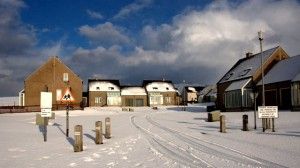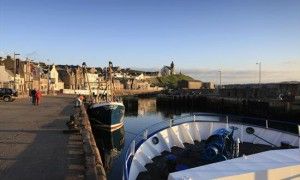Robert Livingston argues that instead of building ‘bridges’ to link contrasting approaches to cultural and economic challenges in Scotland’s islands and its mainland towns, we should instead be treating our towns as if they were distinctive land-locked islands. Robert is indebted to Kenneth Roy’s book ‘The Invisible Spirit’ for some of the background to this blog.
‘No man is an island’, wrote John Donne. But what might it mean if we started to think of towns as if they were islands? How might we treat them differently?
For a start, we might value towns more highly. After all, we had to learn to value our islands. It’s salutary to discover that as recently as the 1950s there were fears that the whole of Mull might need to be evacuated, at a time when the journey from Glasgow to Tobermory could take more than 12 hours. The population removals that had already taken place, from Mingulay in 1912 and St Kilda in 1930, still fester in the collective psyche today, and, as a result, such a concept of complete abandonment is now unthinkable.

Balatasound in Unst, Shetland: the UK’s most northerly island
Individual islands may still face serious challenges, but over the decades collective efforts have been made by both governments and communities, and today several are even seeing their populations increase.
A Hidden Diversity
We value islands because we recognise that every island is different, even those as small as Gigha or Papa Westray. Their unique identities are shaped by geography, climate, history, and past and present patterns of ownership and population. But isn’t every Scottish town equally distinctive, shaped by a similar combination of factors?
An appearance of uniformity may be created by the patterns of Council and commercial housing developments, by ubiquitous chain stores, and by the paraphernalia of roads and traffic management, but it is deceptive. No one would suggest that, say, Banff and Campbeltown are alike even though they may be of similar size, have similarly remote coastal locations, and face similar economic challenges. In what then, does each town’s distinctiveness reside? The answer, of course, is in its culture.
When we talk of ‘island culture’, we mean two things. We mean the particular mix of history, memory, language, and artistic activity, which distinguishes, to take extreme examples, Hoy from Jura. We also mean the culture shared by islands: making do; adaptable; all in it together; informal; self-starting. There are also, of course, negative aspects to island culture… Above all, though, island culture tends to mean self-reliance, and the need to replicate a range of mainland facilities for the benefit of island communities.
What if we started to talk about a ‘culture of towns’? And with a similar double meaning: first, arriving at an understanding of the cultural mix that is unique to each town, and then, evolving an overview of what makes living in towns different from either city or rural living. After all, there is one segment of society for whom the town in which they live is, for most practical purposes, an island—those on low incomes. Just like islands, many of Scotland’s towns face the challenge of replicating facilities and services that are otherwise out of reach in the major cities.

Easterhouse and Unst
Consider the island of Unst, the most northerly part of the UK. With a population of 630, Unst can lay claim to a primary school, a swimming pool, a campus of Shetland College, a festival, a natural and cultural heritage centre, and good broadband coverage. How many of Scotland’s towns, with populations five or ten times that of Unst, are able to claim an equally rich set of community resources?
We now recognise the massive mistake that was made in the 1950s and 60s, when urban populations were ‘decanted’ to edge-of-city estates such as Easterhouse, where a population of over 50,000 (greater than that of Perth or Inverness at the time) was expected to survive without the most basic amenities of shops, sports/recreational grounds, and cinemas, and with poor transport links to where those amenities did exist.

Towns like Banff, Aberdeenshire, have distinct cultural identities
Yet many of our older towns, especially those in post-industrial areas, have lost many such amenities in recent years, or even, in some cases, never possessed them in the first place. Easterhouse first began to coalesce as a community, after all, when it found a means of expressing its cultural identity, through the Easterhouse Festival.
Cultural Dynamics
No one now would doubt that each of Scotland’s islands has an individual contribution to make to the nation’s wider cultural identity, and that identity would be substantially diminished by the future depopulation of even one small island. Where islands are concerned, cultural concerns come first, trumping crude economic arguments. Shouldn’t the same be true of our towns?
There is no more melancholy sight in the whole of the Highlands than a deserted township, where economic hardship or the ‘improvements’ of the Clearances forced a community out. Can we really consider the possibility that this may be the future fate of some of our current ‘failing’ towns, when depopulation reaches the point where core services become unsustainable?
Or should we instead be thinking of each Scottish town as a distinct cultural construct, and therefore begin any process of stimulating regeneration—or, as was recently said, mitigating degeneration—by seeking to understand the cultural dynamics that shape a given community? And at the same time, considering how best to nurture those common island cultural characteristics of self-reliance, adaptability, and innovation, so that, just as on Shetland or Eigg, the communities of towns can take control of their own destinies.
